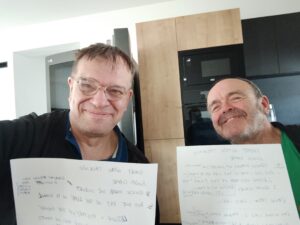It is always frustrating for a teacher when their students won’t speak clearly in class. Teachers may even be driven to say things like ‘Speak up!’ or ‘Come on, don’t mumble!’ However, speaking clearly is not necessarily easy, especially for students who are shy, or anxious, or afraid of making mistakes. It is a skill that needs to be taught and encouraged and that is the theme of this article.
Five Things
This blog is going introduce five things that are key to speaking clearly, They are …..
Eye-contact
Being Still, Being Slow
Speaking Loudly
Hands
Focusing On The Audience
Eye-contact
It is very difficult for an inexperienced speaker to hold good eye-contact with a group of people who are watching them, especially if they are nervous. It is a skill that comes with experience and even with becoming comfortable with public presentation. What inexperienced speakers can do however is not hide their faces.
This means looking straight forwards rather than down at the floor or out of the window or at the ceiling. It also means checking that long hair is kept back away from the face. Audiences respond a lot better to speakers whose faces can be seen.
Being Still, Being Slow
Many speakers seem unsteady on their feet as they are speaking, they sway, walk around, or even stand on one leg. Others will twitch or touch their face, or smile excessively. However, these things take attention away from the content of what is being said. It helps the audience if the speaker is well-grounded and if they give an impression of being still.
Also, people who are nervous tend to rush and speak quickly. It is good to remember that slow is good.
Speaking Loudly
Teachers may tell their students to speak up, but speaking up is not always easy. We all feel strange about speaking loudly in front of other people and it is especially difficult for school students as for most of their lives they have repeatedly been told ….. ‘Keep quiet!, Don’t make so much noise!’ People have to be re-trained and given permission to find their voices.
Here is am activity to help your group find their voices ……
Activity – Counting to ten
Ask the class to count slowly and carefully from one to ten as a group.
Then ask them to do it again where the number 1 is said as quietly as possible, 2 just a bit louder,3 louder again, and so on up to 10 where 10 is meant to be as loud as possible.
What inevitably happens is that the group will have trouble being loud. They will typically get louder up to about number 7 and then the volume will level off. If you do it a few more times though they will start to give themselves permission to be louder.
Hands
Hands can be very distracting and it is a problem to know what to do with them. They do not look good in your pockets, behind your back or hanging by your side. So what then?
I find that the best use of hands is when they make simple gestures to support the verbal presentation. For beginner speakers though I recommend keeping hands visible and above waist level. (Not in pockets, not behind the back, not hanging to the sides or even folded as they hang low). I am not sure why, but hands really look better and are less distracting above waist level.
Focusing On The Audience
This is probably the most important consideration for high-level presentation or acting. It is very easy for people speaking in public to get wrapped up in themselves and their own process, including the technical issues discussed so far here (Am I standing still? Am I speaking slowly enough and loudly enough?), but the main thing we should think about is the audience.
At the end of the day, however it is done, the person talking has to communicate effectively and that is all. If the audience can understand them easily then they are successful and vice-versa. And the biggest key to having the audience understand you is simply thinking about it and caring about it enough to make sure that it happens. It is a question of having the right mindset.


